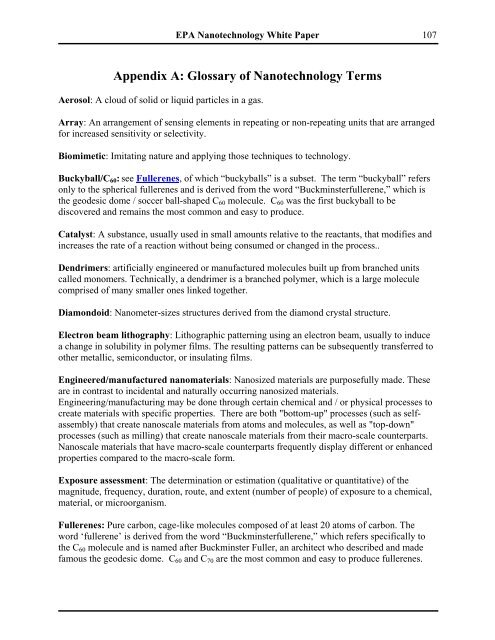Nanotechnology White Paper - US Environmental Protection Agency
Nanotechnology White Paper - US Environmental Protection Agency
Nanotechnology White Paper - US Environmental Protection Agency
Create successful ePaper yourself
Turn your PDF publications into a flip-book with our unique Google optimized e-Paper software.
EPA <strong>Nanotechnology</strong> <strong>White</strong> <strong>Paper</strong><br />
Appendix A: Glossary of <strong>Nanotechnology</strong> Terms<br />
Aerosol: A cloud of solid or liquid particles in a gas.<br />
Array: An arrangement of sensing elements in repeating or non-repeating units that are arranged<br />
for increased sensitivity or selectivity.<br />
Biomimetic: Imitating nature and applying those techniques to technology.<br />
Buckyball/C60: see Fullerenes, of which “buckyballs” is a subset. The term “buckyball” refers<br />
only to the spherical fullerenes and is derived from the word “Buckminsterfullerene,” which is<br />
the geodesic dome / soccer ball-shaped C60 molecule. C60 was the first buckyball to be<br />
discovered and remains the most common and easy to produce.<br />
Catalyst: A substance, usually used in small amounts relative to the reactants, that modifies and<br />
increases the rate of a reaction without being consumed or changed in the process..<br />
Dendrimers: artificially engineered or manufactured molecules built up from branched units<br />
called monomers. Technically, a dendrimer is a branched polymer, which is a large molecule<br />
comprised of many smaller ones linked together.<br />
Diamondoid: Nanometer-sizes structures derived from the diamond crystal structure.<br />
Electron beam lithography: Lithographic patterning using an electron beam, usually to induce<br />
a change in solubility in polymer films. The resulting patterns can be subsequently transferred to<br />
other metallic, semiconductor, or insulating films.<br />
Engineered/manufactured nanomaterials: Nanosized materials are purposefully made. These<br />
are in contrast to incidental and naturally occurring nanosized materials.<br />
Engineering/manufacturing may be done through certain chemical and / or physical processes to<br />
create materials with specific properties. There are both "bottom-up" processes (such as selfassembly)<br />
that create nanoscale materials from atoms and molecules, as well as "top-down"<br />
processes (such as milling) that create nanoscale materials from their macro-scale counterparts.<br />
Nanoscale materials that have macro-scale counterparts frequently display different or enhanced<br />
properties compared to the macro-scale form.<br />
Exposure assessment: The determination or estimation (qualitative or quantitative) of the<br />
magnitude, frequency, duration, route, and extent (number of people) of exposure to a chemical,<br />
material, or microorganism.<br />
Fullerenes: Pure carbon, cage-like molecules composed of at least 20 atoms of carbon. The<br />
word ‘fullerene’ is derived from the word “Buckminsterfullerene,” which refers specifically to<br />
the C60 molecule and is named after Buckminster Fuller, an architect who described and made<br />
famous the geodesic dome. C60 and C70 are the most common and easy to produce fullerenes.<br />
107

















